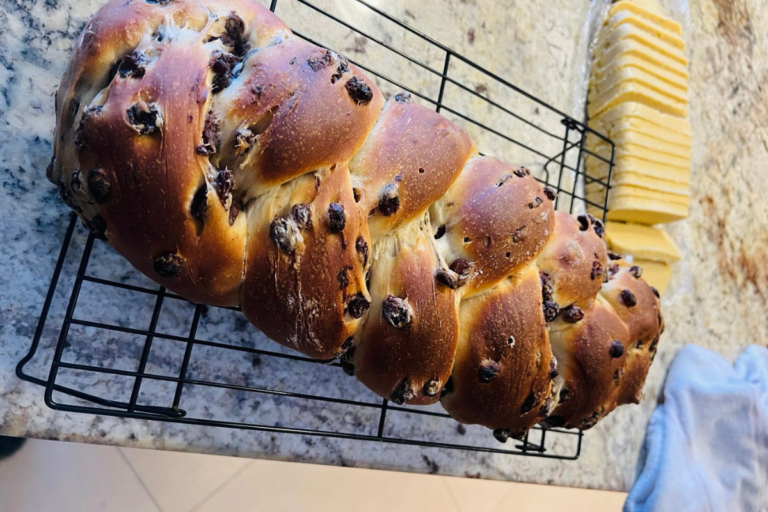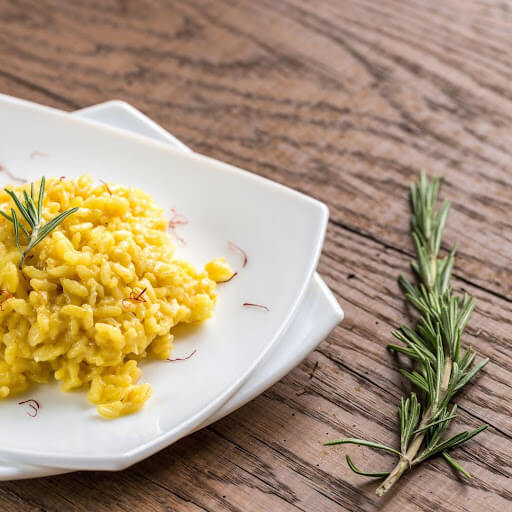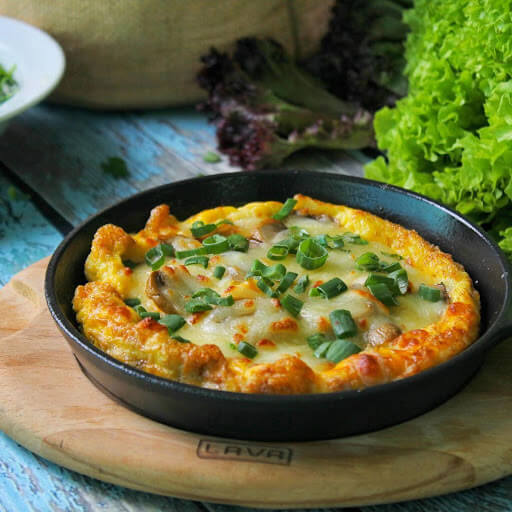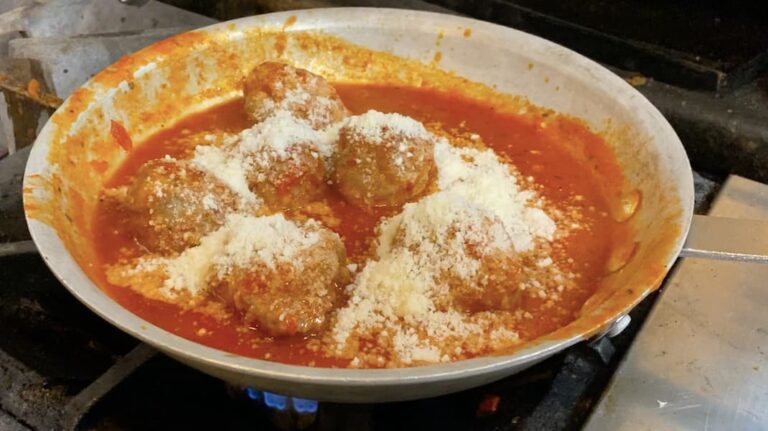Picture this: As you bite into this bread, you notice the slightly crisp crust before it gives in to the soft, chewy inside. While chewing, you’re tasting earthy undertones of olive oil with a hint of sweetness that compliments the juiciness of the grapes – not too overwhelming, not too subtle.
Depending on the grapes you used, you will have a range of sweetness – going from a gentle, mellow note to a more pronounced, zesty flavor – nonetheless, it compliments the different layers of dough. Additions like cinnamon or lemon zest can even introduce a delicate spice or citrusy note to this sweet bread, which adds more layers to the flavor profile and can also balance out the sweetness or zestiness of the grapes that came from the rest grape harvest.
Nonetheless, the rustic, comforting base of the bread gives it a completely new feel to the complimenting flesh, lively sweetness of the grapes – giving you that rustic Italian countryside and artisanal baking charm that you’re craving for.
How to Make Pan con L’Uva (Bread with Raisins)
Here’s what you need for this traditional italian bread:
Ingredients:
For the Dough:
- 500 grams (4 cups) all-purpose flour
- 10 grams (2 teaspoons) active dry yeast
- 250 ml (1 cup) warm water
- 50 grams (1/4 cup) sugar
- 500 grams (3 cups) red or black grapes, washed and dried
- 60 ml (1/4 cup) extra virgin olive oil
- A pinch of salt
- Optional: 1 teaspoon ground cinnamon
- Optional: Zest of 1 lemon
Alternative Ingredients:
- Flour – Whole wheat flour, gluten-free flour blend
- Yeast – Instant yeast, baking powder, baking soda and acid like buttermilk, sourdough starter, beer, self-rising flour
- Sweeteners – Honey, maple syrup, brown sugar
- Oil – Butter, margarine
- Fruits – Mix of red, black, and green grapes, raisins, dried cranberries, chopped dried gifs, walnuts, almonds, pine nuts
- Toppings – Demerara sugar, icing sugar, powdered sugar, stevia, fresh rosemary
Variations:
- If you want to experiment with the recipe a bit, consider making a vegan pan con l’Uva by using plant-based milk and vegan butter.
- Alternatively, you can also bake Pane Bianco, omit the sugar and cinnamon in the filling and create a savory option with olives, sun-dried tomatoes, garlic, and cheese.
For the grape selection, I recommend champagne grapes, strawberry grapes, or wine grapes – check your closest wineries for their harvest season.
You can take really any other ripe grapes though!
Step-by-Step Recipe
Step 1: Take a large bowl and dissolve the yeast in warm water and let it sit for about 5-10 minutes until the dissolved yeast becomes frothy – then add the flour, sugar, olive oil, and salt to the yeast mixture – mix until you have a dough formed using either your hands, a hand mixer with a dough hook, or a food processor.
Step 2: Knead the sticky dough on the surface with a little flour for about 10 minutes until it’s smooth and elastic – you want it to be elastic and not super sticky.
Step 3: Take a medium bowl and grease it with olive oil, then place the dough into it and cover it with a cloth – let it rise in a warm place for about 1 hour, it needs to double in size.
Step 4: While it’s rising, preheat your oven to 180°C (350°F).
Step 5: Once the dough has risen and doubled in size, take it again and punch it down before placing it on a lightly floured surface – then roll it out into a large rectangular shape.
Step 6: Spread half of the grapes over the dough, then sprinkle half of the sugar (and cinnamon or lemon zest if you’re using it) over it as well – roll up the dough along the long side, enclosing the grapes.
Tip: If you want to save time, you don’t have to do anything else to the dough. However, if you want to braid it, you will want to give it a braided look, take a sharp knife and make the cuts from right and left to the middle until you have a braided look.
Step 7: Place the rolled dough on a rectangular baking pan or a baking sheet lined with parchment paper and put the remaining grapes on top of the dough – press it lightly into the dough, so it’ll stick. If you have any leftover dough, wrap plastic wrap around it and place it in the fridge until you’re ready to use it.
Tip: Sprinkle rosemary or other herbs to garnish your bread.
Step 8: Bake the bread dough in the preheated oven for about 45 minutes – you want it to be golden brown and hollow when you tap it (that’s how you know it’s ready!)
Once done, take it out of the oven and let it cool off at room temperature on a wire rack before you cut into it while it’s still warm to enjoy – even better, enjoy it with a glass of Italian wine or a cup of coffee.
Expert Tips
- If you’re short on time, you can pre-ferment dough for a deeper flavor, for this make a mixture of equal parts flour and water with a bit of yeast.
- To give your bread a more aromatic twist, add some rosemary, thyme, lemon, or orange zest to the dough when you’re making it.
- If you’re using dried fruits like raisins, consider soaking them in a little brandy or warm water before adding them to the dough to plump them up and add extra flavor to it.
- When you’re preparing the dough to rise, leave it in a warm, draft-free environment – for this, you can also use a turned-off oven.
- To get that amazing delicious crust, place an oven-proof pan of water in the bottom of the oven to create steam during the first minutes of baking.
What to Serve This Bread with Raisins
Here are some suggestions if you’re looking to make it part of a course to wow your guests!
Appetizers
- Antipasti platter with cured meats like prosciutto and salami, cheeses like mozzarella and Parmesan, olives, and marinated vegetables.
- Olive Tapenade with black or green olives, capers, garlic, and olive oil
- Charcuterie with cured meats such as prosciutto, salami, and mortadella
- Arugula and pear salad
Main Course
- Minestrone soup
- Tomato basil soup
- Roasted or grilled meat
- Eggplant Parmigiana
- Mushroom risotto
Dessert
- Cheese board with Gorgonzola, Pecorino, and Ricotta
- Tiramisu
- Panna Cotta
Beverages
- Sparkling Prosecco
- Chianti
- Barolo
- Vin Santo – a sweet wine
- Moscato d’Asti
- Coffee or Espresso
- Hot tea
Frequently Asked Questions (FAQs)
Got questions? We’ve got answers!
What type of grapes should I use for Pan con l’Uva?
For this recipe, you can use either red or black grapes, though, for convenience, use seedless grapes. You could even consider using a mix of both as each type of grape will change the flavor slightly.
How do I know when the bread is fully baked?
You will know if your pan con l’Uva is done when it’s golden brown on the outside and sounds hollow when tapped on the bottom. You could also try measuring the temperature if you want to make sure you’re on the safe side – for this, it should be 190°F to 200°F (88°C to 93°C) inside.
Can I use dried grapes or raisins instead of fresh grapes?
Yes! You can use either raisins, other dried grapes, or fresh grapes – though the texture and moisture will be different in the bread, so just keep that in mind. As a tip If you’re using dried fruit, consider soaking them in warm water or juice to plump them up before adding to the dough.
Is it necessary to let the dough rise twice?
Nope! While both are important as the first rise allows the dough to develop flavor and texture, while the second rise after shaping helps create a lighter bread – you can skip the second rise as I did in this recipe here. If you decide to have a second rise, do so after step 4 after you’ve punched it down and kneaded it again.
Print
Pan con L’Uva | Pane All’uva | Bread with Grapes
5 Stars 4 Stars 3 Stars 2 Stars 1 Star
No reviews
- Author: Anna Dykeman
Ingredients
For the Dough:
- 500 grams (4 cups) all-purpose flour
- 10 grams (2 teaspoons) active dry yeast
- 250 ml (1 cup) warm water
- 50 grams (1/4 cup) sugar
- 500 grams (3 cups) red or black grapes, washed and dried
- 60 ml (1/4 cup) extra virgin olive oil
- A pinch of salt
- Optional: 1 teaspoon ground cinnamon
- Optional: Zest of 1 lemon
Alternative Ingredients:
- Flour – Whole wheat flour, gluten-free flour blend
- Yeast – Instant yeast, baking powder, baking soda and acid like buttermilk, sourdough starter, beer, self-rising flour
- Sweeteners – Honey, maple syrup, brown sugar
- Oil – Butter, margarine
- Fruits – Mix of red, black, and green grapes, raisins, dried cranberries, chopped dried gifs, walnuts, almonds, pine nuts
- Toppings – Demerara sugar, icing sugar, powdered sugar, stevia, fresh rosemary
Instructions
Step 1: Take a large bowl and dissolve the yeast in warm water and let it sit for about 5-10 minutes until the dissolved yeast becomes frothy – then add the flour, sugar, olive oil, and salt to the yeast mixture – mix until you have a dough formed using either your hands, a hand mixer with a dough hook, or a food processor.
Step 2: Knead the sticky dough on the surface with a little flour for about 10 minutes until it’s smooth and elastic – you want it to be elastic and not super sticky.
Step 3: Take a medium bowl and grease it with olive oil, then place the dough into it and cover it with a cloth – let it rise in a warm place for about 1 hour, it needs to double in size.
Step 4: While it’s rising, preheat your oven to 180°C (350°F).
Step 5: Once the dough has risen and doubled in size, take it again and punch it down before placing it on a lightly floured surface – then roll it out into a large rectangular shape.
Step 6: Spread half of the grapes over the dough, then sprinkle half of the sugar (and cinnamon or lemon zest if you’re using it) over it as well – roll up the dough along the long side, enclosing the grapes.
Tip: If you want to save time, you don’t have to do anything else to the dough. However, if you want to braid it, you will want to give it a braided look, take a sharp knife and make the cuts from right and left to the middle until you have a braided look.
Step 7: Place the rolled dough on a rectangular baking pan or a baking sheet lined with parchment paper and put the remaining grapes on top of the dough – press it lightly into the dough, so it’ll stick. If you have any leftover dough, wrap plastic wrap around it and place it in the fridge until you’re ready to use it.
Tip: Sprinkle rosemary or other herbs to garnish your bread.
Step 8: Bake the bread dough in the preheated oven for about 45 minutes – you want it to be golden brown and hollow when you tap it (that’s how you know it’s ready!)Once done, take it out of the oven and let it cool off at room temperature on a wire rack before you cut into it while it’s still warm to enjoy – even better, enjoy it with a glass of Italian wine or a cup of coffee.









